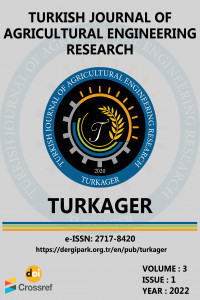Design and Performance Evaluation of Grain Feed Grinding Machine
Design and Performance Evaluation of Grain Feed Grinding Machine
Hammer mill, Blade shape Sieve size, Efficiency,
___
- Adekomaya O and Samuel O (2014). Design and development of a petrol-powered hammer mill for ruralnigerian farmers. Journal of Energy Technologies and Policy, 4(4): 65-72.
- Admasu F, Getahun A and Wakjira M (2019). The process of tilapia feed formulation and implementation in pond aquaculture: low cost and locally available ingredients option for small-scale farmers. Journal of Agriculture and Aquaculture, 1(2).
- Ajaka E and Adesina A (2014). Design, fabrication, and testing of a laboratory size hammer mill. International Journal of Engineering and Advanced Technology Studies, 2(2): 11-21.
- Aboud BA (2012). The effect of sieve holes and types of grains on some performance indicators of hammer mill. Diyala Agricultural Sciences Journal, 1(4): 181-188.
- Ebunilo PO, Obanor A.I and Ariave GO (2010). Design and preliminary testing of a hammer mill with end section lift capability suitable for a commercial processing of grains and solid minerals for in Nigeria. International Journal of Engineering Science and Technology, 2(6): 1581-1593.
- Ezurike OB, Osazuwa JO, Okoronkwo AC and Okoji IK (2018). Design, construction and performance evaluation of a flat screen hammer mill machine. African Journal of Science, Technology, Innovation and Development, 10(6): 683-690.
- Gashaw G (2018). Fisheries commitee for the West Centeral Gulf Guinea from Ethiopia: Attempt to up livestock, fishery sector: http://allafrica.com/stories/201801310946.htm (07/01/2022).
- Gupta J and Khurmi R (2005). A text-book of machine design elements. Eurasia Publishing House, New Delhi.
- Higgs D and Hasting W (2011). FAO-Food and Agricultural Organization. https://www.fao.org/3/x5738e/x5738e0j.htm#2.%20grinding
- Mohamed T, Radwan H, Elashhab A and Adly M (2015). Design and evalute of small-scale hammer mill. Egypt Journal of Agricultural Research, 93(5): 481-493.
- Nisbett K and Richard B (2010). Shigley's mechanical engineering design. United States: McGraw-Hill science, New York.
- Stephens and Richard C (2005). Mechanics of machines. Edward Arnold, New York.
- Suresh V (2018). Fish nutrition feed resaecrh: scope and challanges ahead. ICAR-Central Marine Fisheries Research, 23(1): 78-81.
- Tesfahun A (2018). Review in current problems of Ethiopia fishery: In case of human and natural associated impacts on water bodies. International Journal of Fisheries and aquatic Studies, 6(2): 94-99.
- Zhou K (2018). Feed processing technology Effect of grinding particle size on feed quality. https://www.viv.net
- Yayın Aralığı: Yılda 2 Sayı
- Başlangıç: 2020
- Yayıncı: Ebubekir ALTUNTAŞ
Design and Performance Evaluation of Canola-Seed Cleaning Machine
Mohamed GHONİMY, Mohamed ROSTOM
Patricia ORİAKU, Christopher OBİNECHE, Ezechıke NKECHİ UDOCHUKWU, Ezema PATİENCE CHİNASA
Ide PATRICK EJIKE, Ikoko OMENAOGOR, Helen ONYEAKA
Hilary UGURU, Ovie AKPOKODJE, Goodnews Goodman AGBI
Application of Value Engineering to Identify and Solve Irrigation Water Allocation Problems
Nura Jafar SHANONO, Nuraddeen Mukhtar NASİDİ
David ONWE, Adeleke Isaac BAMGBOYE
Patlıcan (Solanum melongena L.) Kuruma Kinetiği ve Renk Değişimi
Hüsne GÖK, Mehmetcan OLGAÇ, Hakan POLATCI
Quality Evaluation of Foam Dried Watermelon Flakes
John ISA, Ayoola OLALUSİ, Omoba OLUFUNMİLAYO
Cordelia Chika EMEKA-CHRİS, Christopher OBİNECHE, Bejoy Otuobi UNANKA
